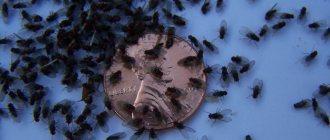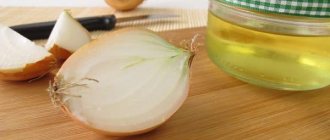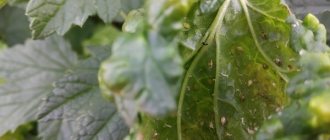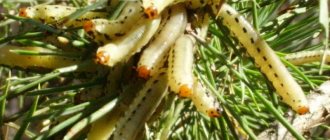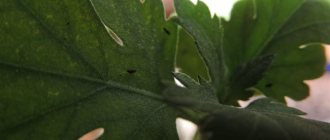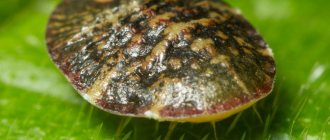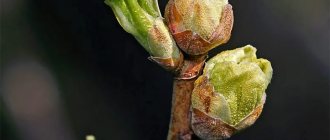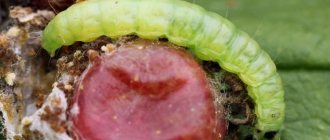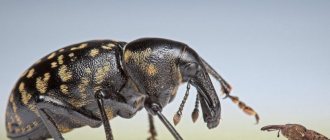Violets are common among gardeners due to their high decorative value. Many varieties not only have beautiful flowers, but also boast variegated foliage.
When Saintpaulias lose their decorative appearance, you need to think about why this happened. First of all, it is necessary to exclude mite infestation of the violet.
Ticks are divided into 3 categories:
- soft-bodied - a small transparent tick, elliptical in shape, reaching a length of 0.2 to 0.3 mm. Prefers to settle at plant growth points;
- armored - has more than 6,000 representatives; in home collections there are round, shiny black mites that live in the substrate. Harm occurs when the insect colony reaches a very large size;
- cobwebby and flat – has a red or green color, an oval shape ranging in size from 0.3 to 0.5 mm. Weaves a thin web in which he lives. It reproduces very quickly: 10-20 days pass from the beginning of egg laying to the adult individual. The total lifespan is 4-5 weeks.
Spider mite (close-up photo).
Flat beetle mite (photo under a microscope).
Transparent, cyclamen or strawberry mites love to eat Saintpaulias
Cyclamen mite (photo of an infected violet).
Next, we will show photos of signs of infection and tell you how to deal with spider mites and other categories of these pests.
Attention! Due to their tiny size, it is impossible to notice mites on the plant with the naked eye. The collector can only observe the consequences of their distribution.
Ticks - what kind of “living creatures” are they?
There are many varieties of ticks. But it is Saintpaulia that is often affected by three types of herbivorous parasites:
- strawberry mite,
- transparent greenhouse,
- cyclamen.
By and large, there is no need to find out exactly what type of mite has infected your violet, since this can only be found out through careful examination under a magnifying glass. In any case, most acaricides (chemical anti-mite drugs) act on many varieties of these pests.
But you still need to know something about ticks:
- These are not insects, but arthropods. Products designed to kill insects may not work on them.
- Often, several types of mites appear on a flower at once.
- Organisms can develop resistance to poisons, so medications must be constantly changed.
- Ticks are very tenacious, it is better not to waste time on various folk remedies that may not work, but to immediately treat the flowers with chemicals.
- If the plant has been attacked by pests once, it is recommended that after treatment it is treated for prevention once every 2-3 months, since mites can go into long hibernation.
Why are spider mites dangerous for plants?
- Spider mites feed on the sap of the plant they capture . Adults have proboscis , with which they pierce the outer layer of the stem at the root of the plant, injecting their liquid with enzymes there. And they immediately begin to actively engage in cellular chloroplasts, intensively destroying them.
- After the mites, through their “friendly efforts,” deplete the indoor flower, they immediately move to healthy individuals. If you notice traces of mites in one of the flower pots, you should take a close look at all the others in the same room. Most likely, these small colonizers have already settled in them.
Dangerous pest
Description and appearance
Most often, the cyclamen mite appears on violets, which also affects other indoor plants. Azaleas, Kalanchoes, and cyclamen are at greatest risk of infection. But these pests harm not only indoor flowers, they also affect garden and vegetable crops. They have very small body sizes and it is simply impossible to see them on a flower without magnifying devices. They belong to the arachnids.
They have a translucent, oblong body, light yellow in color, and 8 legs. They live in buds and on young shoots. Their diet consists of plant sap. These pests multiply very quickly and within a few days after infection the colonies increase significantly.
One female lays 12 to 16 eggs daily, which require only 3-7 days to develop. A week after laying eggs, young individuals appear, which need nutrition and are ready for further reproduction. You can see what they look like in the photo.
Favorable conditions that contribute to their rapid reproduction are warmth and minimal humidity. Therefore, the peak of their activity for indoor plants occurs in winter, when apartments have heating. And for garden crops, such a favorable environment occurs in the summer, when hot and dry days arrive.
Other types of ticks
- Unfortunately, not only the cyclamen mite is dangerous for violets; plants can also infect other types of mites. One of them is a cobweb, which is no less dangerous and can lead to the death of a violet. These are small parasites that reach no more than 1 mm. In the warm season, they have a green body color, and in the fall and spring they change it to red.
- It is dangerous not only for violets; the pest affects berry and fruit crops. They also feed on plant sap. The product of their vital activity is a cobweb that envelops the flower, and it is by this that the infection can be determined. Acaricides and folk remedies are quite effective in combating it.
- Another dangerous species is the flat beetle; this mite affects violets, cacti, ficus, citrus fruits and other types of indoor plants. It has an ovoid body shape and can be yellow-orange or yellow-brown in color. When infected, the leaves begin to dry out, the plant weakens greatly and dies. Favorable conditions for reproduction are temperatures of 18-24°C, so they lay eggs all year round, which is why they pose a great danger. Acaricidal agents are used to combat them.
- Violets and root mites, as they are also called bulb mites, are not ignored. They infect plants underground; most often, orchids, gladioli, tulips, etc. are attacked by these pests. High humidity serves as favorable conditions for their reproduction. Bulbs should be stored only in dry rooms where the humidity level does not exceed 60%, which is an effective prevention.
Signs of defeat
Since it is impossible to see the pest on a violet, infection can be determined from the external signs that appear on the flower. Something similar to a dusty coating appears on young shoots, buds, as well as young green leaves. The mite infestation is most noticeable on the leaves, as they change color, become dull, a yellow tint appears, then they turn brownish-gray and the leaves become deformed.
The petioles and leaves become very dry and brittle. Also, thin hairs similar to cobwebs appear on young leaves. The buds do not open and begin to fall off.
If such signs are detected, it is necessary to relocate the infected flower so that the pests do not attack neighboring flowers. You will need to immediately resort to treatment methods.
Symptoms of mites on violets
The difficulty is that it can be difficult to understand why a violet is sick. These parasites are invisible, and their presence is indicated only by painful signs that can be confused with other causes.
And yet, we will try to highlight the main symptoms that are more characteristic of a tick-borne scourge:
- Saintpaulia leaves droop and the plant looks drooping.
- The petioles become brittle and sometimes fall off when touched.
- White, yellow, and brown spots may appear on the leaves.
- The edges of the leaves darken and curl.
- The plant does not bloom, and if there are buds, it does not bloom, quickly withering.
- The color of the leaves changes, becomes dull, and a coating appears on top.
- When you feel the leaves, you can feel the tubercles (deposited mite larvae).
- Flower growth slows down.
Note: mites love moisture, so they often nest in the rosette part of the violet closer to the soil. But if the plants live in greenhouses with high air humidity, then the parasites will be comfortable on any part of the violets.
General information
Members of the family Tenuipalpidae (flat mites) are close relatives of spider mites, for which they are sometimes called false spider mites . The main anatomical difference between these groups is that in spider mites the body is solid, while in flat mites it is divided by transverse sutures into several parts (anterior, middle and posterior).
Larva of the flat beetle Brevipalpus obovatus
Flower growers encounter representatives of two genera of flat mites - Brevipalpus and Tenuipalpus . Brevipalpus russilus (=Hystripalpus russilus, =Tenuipalpus cactorum) - the cactus flat beetle is a dangerous pest of cacti. Tenuipalpus pacificus severely damages orchids and ferns. It is sometimes called the phalaenopsis mite . Also pests of orchids are the oncidium flat mite (Brevipalpus oncidii) and the greenhouse flat beetle (Brevipalpus obovatus) . Various representatives of flat mites (the most famous, about 40) harm grapes, citrus fruits, palm trees, unabi, privet, ivy, milkweed, rosaceae, ficus and many other tropical and subtropical plants. Accurate identification of pests of this group is extremely difficult. There is no available definitive literature and no consensus on the taxonomy of these mites.
We will talk in detail about the greenhouse flat beetle - Brevipalpus obovatus , since it is the one that damages violets and other gesneriaceae. In Russian-language sources, this species can be called greenhouse flat beetle, common flat beetle, red flat mite, orange flat mite , etc.
Male flat beetle Brevipalpus obovatus
Female flat beetle Brevipalpus obovatus
Flat beetle Brevipalpus obovatus - side view
Detection and control measures
Among the most dangerous mites, the one that primarily attacks indoor plants is the cyclamen mite (Phytonemus pallidus). Its dimensions are measured in microns, so the parasite can only be seen under a microscope.
However, the mite affects not only cyclamens; it can seriously harm Saintpaulia, Gloxinia, Kalanchoe, balsams and other indoor plants. As a rule, larvae and adults settle at the growth point, while young leaves become deformed, wrinkled and covered with gray or brown fluff. Flowers do not bloom, buds fall off.
The cyclamen mite develops very quickly in warm conditions and high humidity. Severely affected plants appear as if covered in dust.
Ticks reproduce extremely quickly. The young generation can be formed every three weeks, and under suitable conditions even after two. Therefore, if infection is suspected, the affected plants should be separated and fenced off.
Detection of cyclamen mite
The presence of an uninvited guest can be judged only by indirect external signs. In Saintpaulia, the main thing to pay close attention to is the deformation of flowers, which take on an unusual shape, often do not open at all, fly around at the bud stage, and have an abnormal color. The shoot is deformed, fresh leaves are affected, and they curl in every possible way. Long hairs on young leaves are clearly visible.
In other plants, these mites also often provoke deformation and depigmentation of damaged plant organs. They lead to drying out and deformation of the shoots, and changes in the shape of the leaves. Flowers may develop spots and may not bloom. These pests love high humidity, so they usually settle in the folds of young leaves, in the buds, where there is more moisture.
Prevention of occurrence
Regarding prevention, there are no particularly effective methods in this case. The housewife must regularly monitor the general health of all her houseplants.
As soon as one of these signs is identified, the fight against the tick should be started in a timely manner. If this is not detected in time, then in addition to the death of the affected plant itself, all the flowers located in the house may fall into the danger zone.
Measures to combat the cyclamen mite
If there is a suspicion that a plant is infested with a mite, it must be immediately isolated from other flowers. If there are few infected specimens, then the parasite can be destroyed by treating the plants with warm water (up to 40–45 °C). All habitats of the parasite are removed from the affected flower and kept in water together with the pot for approximately 15 minutes, trying to maintain the required temperature throughout the treatment. The disinfected flower is moved to a warm place for 2-3 days, protected from the sun.
Significantly damaged specimens are easier to propagate from healthy lobes, and destroy everything else, preventing the spread of the parasite.
You can also fight the cyclamen mite with chemical means. When choosing a drug, it is necessary to take into account that ticks are not insects, and drugs to combat parasitic insects will not affect them. They should be combated with specialized means - acaricides.
A characteristic feature of pests is their fertility, which is why they quickly adapt to poisons. When destroying them, it is necessary to continuously change the drugs used. Acaricides must be used at least 3 times, each time using a different drug. This is explained by the fact that not all drugs act on all generations of parasites. The next time you use a new drug, you increase the likelihood of killing parasites of all ages. The most effective remedies are considered to be Sunmite, Neoron, Omite.
The products must be used outdoors or in non-residential premises with good ventilation. When treating the plant, you should also treat the soil in the pot. You can increase the effectiveness of the products if you place the treated plant in a plastic bag and wait at least eight hours.
Preparations that exterminate ticks are very toxic and pose a danger to humans; when using them, it is necessary to use personal protective equipment.
After completion of the treatments, flowers are placed in quarantine and kept away from other specimens. After about a month, when new shoots appear and no symptoms of mites are detected, the flower can be returned to its old place.
How to get rid of it: step-by-step instructions
If mites are found on a rose, first of all it should be isolated from other plants.
Then try to get rid of the parasites mechanically:
- Remove the damaged part of the flower with pruning shears.
- Wash the leaves with soapy water.
- Increase the humidity to 80-90% by dipping the flower in a container of water and then wrap it in cellophane.
If there are large numbers of Tetranychidae, it is worth using one of the following means.
Folk remedies
These products can be combined with chemicals or used independently.
- Alcohol. For 250 ml of clean water you need 2 teaspoons of alcohol. Spray the foliage with this mixture. But to avoid burning it, after an hour, moisten the leaves with water from a spray bottle.
- Garlic. Crush the head of garlic and add a liter of water. Leave for 5 days in a dark place, then process the rose.
- A decoction of onion peels and dandelion. Apply once every 4-5 days.
Chemicals
The most effective drugs to combat spider mites are called acaricides. They can be special for ticks or universal. They are sold in the form of emulsions or suspensions. These products destroy the adult, but the eggs remain intact, so it is recommended to carry out 3-4 treatments to completely eliminate the pests.
The following drugs have worked well:
- "Aktellik";
- "Acartan";
- "Apollo"
- "Tedion";
- "Nitrafen".
Biological products
Today, drugs created from the spores of Bacillus thuringiensis are popular. They are quite safe for humans, animals, plants, and birds.
Russian products made from soil bacteria:
- Biotlin;
- Fitoverm;
- Entobacterin;
- Bitoxibacillin.
Many of them also help in the fight against caterpillars that eat leaves.
Fighting methods
There are many ways to combat this microscopic pest. You can use specialized chemicals or seek help from traditional methods.
Traditional methods
The most effective methods include bathing the violet at a certain water temperature. The procedure is as follows; at the first stage, you will need to remove severely affected leaves. Next, take a container and pour water at a temperature of 45°C into it. You will need a thermometer, since this method is effective precisely at this temperature; if it is higher, then you can harm the plant, and if it is insufficient, then the procedure will not bring any effect.
Next, you need to immerse the flower completely in water for 15 minutes. It is also necessary to maintain the correct temperature during the procedure. After the water procedure, it should be placed in a shaded place, and after a few days it can be returned to its original place.
Chemicals
As with traditional methods, a mandatory step is to remove the affected parts. Most often, acaricidal agents are used for treatment, which must be used to wipe the violet leaves. These include Akarin, Fitoverm, Aktofit, and others. Wiping is carried out every 3 days, then the time intervals are increased to 5. When the bush is very infected, they do not use wiping, but bathing, when the flower is completely immersed in the solution.
If we talk about insecticides, they are ineffective against pests. This is because ticks develop immunity to the active ingredients; in addition, the products are not capable of destroying egg laying. When carrying out treatments with acaricides, it is necessary to carry out several procedures in which the products are changed.
Antiklesch, Omite, Kleschevit, Neoron show fairly good effectiveness. But remember, treatment with these products should not be carried out in an apartment. After the procedure, the violet is covered with plastic wrap for up to 24 hours. The drugs are toxic and when using them, protective equipment must be used.
Use of chemicals
The first step in treating mites should be the complete elimination of all affected parts of the plant and infected flower stalks. Then it is necessary to wipe the leaves and other green parts of the violet using acaricidal agents: Actofit, Fitoverm, Akarin, Agravertin. To completely get rid of ticks, the procedure must be repeated every 3 days, and then every 5 days. If the damage is severe, it is recommended to completely dip the violet bush into a solution with acaricide or avermectin agents.
On a note!
Popular chemical insecticides have no effect on ticks at all. Arthropods very quickly develop resistance to the poison, and it does not destroy their eggs - they can remain viable for several years.
Chemical measures to combat ticks involve frequent changes of drugs to increase the effectiveness of the fight and reduce addiction to them. Therefore, treatment with acaricides should be carried out in several stages, changing the drug each time.
Such drugs as Kleschevit, Antiklesch, Neoron, Sunmite, Omite have a good effect on ticks. However, the treatment should be carried out in a non-residential area, and after spraying the violets should be covered with polyethylene for 8-24 hours.
Chemical pest control
Due to the high toxicity of these drugs, it is necessary to use personal protective equipment (respirator, gloves and protective clothing).
Precautions when processing violets:
- Do not prepare the solution in containers intended for food;
- there is no need to add soap, since alkalis are incompatible with avermectin products;
- all prepared solutions should be used quickly, and then the remains should be destroyed;
- Treatment cannot be carried out in a residential area - it is dangerous for the health of people and pets.
Important!
After processing and treatment, the violet bush must be quarantined, that is, isolated from healthy specimens. And only after 3-4 weeks, after the appearance of fresh shoots and the obvious absence of signs of mites, the flower can be moved to its usual place.
Anti-mite treatment
How to treat : everything is simple and straightforward - the plant must be thoroughly sprayed with the preparation until it is “very wet”, so that not a single untreated square millimeter of surface remains on the entire plant, and not just on the leaves. Just like that, casually spraying on the leaves “for prevention” is an empty and useless exercise. In general, treatments for preventive purposes have the same basis and meaning as drinking medicine by a healthy person in order to prevent a disease. Drug treatments are not plant vaccination; they only make sense if a pest is present.
The frequency and frequency of treatments with avermectins and any preparations in general depend on the type of pest (the time of reproduction of the pest from egg to egg, the presence of periods of non-feeding of the larvae, etc. are taken into account). In turn, the development time of the mite depends on the ambient temperature, which must also be taken into account for the correct choice of treatment schedule. The minimum period between treatments is 3 days, selected at a temperature of about 30*C, when the mite reproduces as quickly as possible. At a temperature of about 20*C, treatments can be carried out after 5 days, but their number remains the same - at least three, and it is better to do four treatments. And, of course, treatments with avermectins lose their meaning at temperatures below 18*C, at which mites stop feeding and go into diapause.
By the way, when treating with Fioverm, it is reasonable to minimize the penetration of the drug into the soil; the roots, if the drug flows abundantly into the ground, may suffer from the alcohol contained in the drug.
Acaricide treatment scheme. We attack everyone at once: nymphs, eggs and adults
Plants should be treated following the recommended sequence:
- Sunmite is used. It destroys pests at any stage of development. Recommended concentration: 1 g of product per 1 liter of water. A single application of the substance is enough to kill even pest eggs.
- To increase the reliability of the method, re-processing is performed, but with a different means - Nissoran. It is enough to take a 5-day break between procedures. Component ratio: 0.5 g of substance per 1 liter of water. Moreover, this product must be mixed with another (choose any drug from the avermectin group, for example, Fitoverm), it is diluted: 10 ml per 1 liter of liquid. Both solutions are used after the primary treatment of violets with Sunmite has been carried out.
Frequently using the same products is not recommended due to the risk of parasites developing resistance.
Basic methods of struggle
Traditional methods do not destroy mites on violets, but only stop their development. However, before treating violets against mites with chemicals, make sure they are properly cared for.
In order to completely rid Saintpaulias of pests, it is necessary to provide them with optimal conditions:
- temperature no more than +24 °C;
- air humidity more than 45%;
- lighting about 2500 Lux;
- daylight hours 10-12 hours;
- optimal watering;
- loose soil not overfed with nitrogen.
In cases where it is impossible to provide the flowers with a lower temperature and high humidity, it is necessary to provide the violets with weekly water treatments. Except for those specimens that have rotten leaves or the plant has lost turgor.
The leaf blades of adult violets should be washed from the underside with warm running water. You need to feel the small tubercles, which are nothing more than egg-laying sites, and remove them. The leaf plates bent inward must be carefully straightened and washed, as mites are located there.
Try to avoid getting water into the growing point. If this happens, blot the moisture well with paper napkins. Washed plants should be allowed to dry in a warm, dark room.
Running water helps get rid of tick nests.
But the most reliable and effective way to get rid of ticks is to treat Saintpaulia with acaricides. These drugs are divided into 3 groups:
- contact acaricides that penetrate the tick’s body through the skin;
- intestinal acaricides acting on insects through the mouth;
- systemic acaricides impregnate the roots and leaves of plants, making it poisonous to pests.
It is best to use a drug that immediately affects adults, nymphs and eggs. In this case, one tick treatment is enough.
It has now become possible to purchase drugs that are responsible not only for the complete destruction of pests in one treatment , but also do not pose a danger to people and pets. In addition, they are completely odorless. Here's how to treat violets against mites using the following preparations:
- Sunmite;
- Starmite;
- Mobento;
- Doni getter.
How to get rid of a tick if you couldn’t buy such drugs? In this case, it is necessary to take acaricides with different active ingredients , since mites very quickly acquire resistance to one drug.
In this case, violets will have to be processed at least 3-5 times every 7-10 days.
In addition to processing the Saintpaulia, it will be necessary to process not only the place where it was located, but also the other plants standing next to it.
Causes of infection
Violets are delicate plants that require proper care. The slightest violation of agricultural conditions will lead to an invasion of parasites.
Conditions that are comfortable for ticks are unfavorable for Saintpaulias:
- ambient temperature above +250C (optimal for violets 18-240C);
- insufficient lighting (plants need 13-14 hours of daylight);
- low humidity (violets develop organically in residential premises);
- excess nitrogen fertilizers (Saintpaulias require moderate feeding).
The condition of the soil also matters. The denser the soil, the greater the risk of mites infesting the flower pot.
Methods for controlling mites on flowers
The fight against cyclamen mite on violets can be done in various ways:
- use of folk recipes;
- use of chemicals.
The most popular folk remedy is to immerse the affected violet bush in hot water at a temperature not lower than 45°C. All affected parts of the flower must first be removed. The duration of the “bathing” is 15 minutes, but it is necessary to maintain a constant water temperature at the desired level.
After the water procedure, the bush is placed in a shaded place to allow it to recover for several days. Then it can be returned to its original place.
What indoor plants are affected by spider mites?
- Absolutely every indoor plant can be attacked by spider mites.
- But, nevertheless, among all the others, at first they will prefer to feast on representatives of the following families: arrowroot, citrus, kutra and araceae.
How to get rid of mites on specific plants?
Orchid
- This delicate flower does not tolerate soaking, as it is harmed by stagnation of water in the areas where the leaf axils are located. Excessive waterlogging can lead an orchid to a variety of putrefactive diseases.
- To prevent such a problem from arising, it is enough to immerse the orchid, together with the container in which it grows, in water with an acaricide diluted in it. After the procedure, the flower should be thoroughly blotted with a soft cloth, especially in the axils of the leaves.
- To carry out chemical treatment of orchids, you can use gentle preparations - “Fitoverm” or “Akarin”. To moisten the soil and at the same time get rid of ticks, add 5 grams to water (0.5 l). "Fitosporina-m."
Rose
- Ticks love to settle on roses more than any other flower, so they should be monitored most carefully. As soon as you notice their first signs on the flower, without hesitating for a second, start saving it.
- Wash the rose with warm soapy water, and then wrap it in cellophane for a day. Then wash it with a warm shower and sprinkle with garlic infusion (see recipe above). If time is lost, it is best to treat the rose with mites infested with Neoron.
Many plants are affected
Balsam
- Fleshy balsam stems and leaves are also very attractive to pests. If ticks appear on it in the spring or summer, wash it with soap and then treat it with Sunmite.
- If an invasion of ticks occurs in the autumn-winter, then the balsam will also need pruning. It is better not to fight with too large a colony of insects, but simply throw away the flower.
Ficus
- Ticks love to settle on ficus trees, so for preventive purposes it should be sprayed with preparations from time to time. But if they have already chosen a plant for themselves, then in this case its leaves will need to be wiped with soapy water and wrapped in a plastic bag.
- Let the ficus stand in this form for 24 hours, then it should be washed from soap and sprayed with calendula infusion.
Violet
- You can’t do water treatments for violets; excess moisture can cause its leaves to rot.
- Having thoroughly examined the violet, you should remove the infected leaves from it, and then spray it twice with Fitoverm - the second time after 10 days.
Dracaena
- First of all, the plant should be washed with water and laundry or tar soap. If the case is advanced, treat the dracaena with a gentle chemical such as Fitoverma .
- Green soap will be an excellent preventative against ticks for dracaena.
Anthurium
- As soon as you notice the appearance of mites on the anthurium, immediately begin removing the infected leaves. The second step should be to wash the plant with soapy water. It is best to transplant it into another pot with fresh substrate.
- If the mites are not completely removed, treat the flower with Akarin , and if this remedy does not have the desired effect, then use, for example, the chemical preparation Bi-58.
Prevention measures
Before taking urgent measures to destroy the pest colony and save Saintpaulia from death, it is necessary to carry out preventive measures:
- immediately treat a newly purchased violet with an acaricide and quarantine it for 3 weeks - this is how much time passes from the moment of infection until the tick turns into an adult. This applies to stepchildren and cuttings. After processing, put the latter for rooting;
- maintain plants in accordance with optimal conditions;
- remove dry, old and rotting leaves and flower stalks;
- wash Saintpaulias in the shower in the heat;
- do preventive treatment with acaricides before critical seasons;
- Do not place flowers close to each other.
Advice! If it was not possible to avoid mite damage and it is necessary to save this variety, then after treating it with an acaricide, try to root the cuttings. Try to select a leaf without traces of infection. To prevent fungal diseases, treat planting material with a fungicide.
Recommendations for preventing spider mites
Some preventative actions can protect your indoor flowers from the invasion of mite colonies.
Protect your plant from pests
For this:
- When buying a new plant or replanting an old one, carefully inspect both the flower itself and the soil for the presence of parasites. Do this with a magnifying glass - this will make it easier for you to spot them.
- For 2-3 weeks, place the new plant separately from all others in the house.
- Regularly inspect all your indoor flowers so that, if necessary, you can immediately begin saving them from parasites.
- Do not be lazy before planting the plant to disinfect the substrate and expanded clay. For this, potassium permanganate diluted in water or calcination for forty minutes in the oven is suitable (the temperature must be set to 180°C). You can also steam the soil in a sieve on a layer of gauze - this will require an hour-long water bath. The soil should be enriched with yeast or some other bacterial fertilizer.
- Treat flowers from time to time using special fungicides. You can use “Fitosporin”, “Alerin”, “Agate”, “Baktofit” or a similar drug.
- Wash the leaves of your plants regularly in a warm shower.
- Humidify the air with a humidifier or spray bottle.
- If you follow all these simple rules, you can protect your indoor plants as much as possible from the risk of dangerous pests, which are spider mites.
Useful articles on the site:
- Climatic zones for plants according to frost resistance in Russia
- How to properly feed house plants
- How and why to pollinate plants by hand
- Why do the leaf edges of indoor plants dry out: top 7 reasons
- Types of manure and its benefits for different plants
